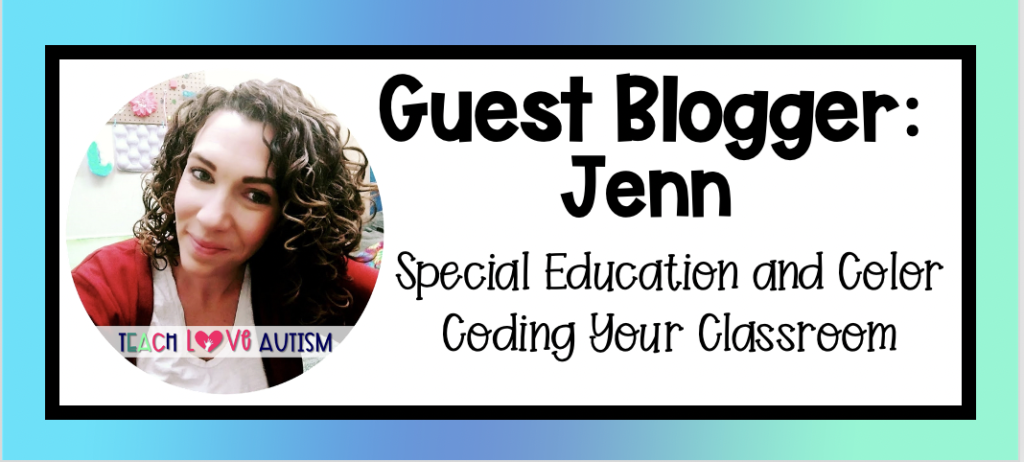I’m excited to introduce this week’s guest blogger! Jenn from Teach Love Autism to talk about how to use color coding in your classroom!

As special educators, we are always expressing our love of visual and environmental supports for our students. It would be hard for me to fully express the importance of this for our kids. However, it would be a crime for me to not acknowledge how important those supports can be for us adults, too! In this blog, I plan to share with you how color coding your special education classroom can change your life!
My favorite universal support for students AND staff will always and forever be the gift of color coding! While color coding your special education classroom can take a little frontloading, it pays off immediately and the benefits long outlast the time it takes you to get organized. This simple technique will help transform your classroom into the well oiled machine you have been dreaming of.
Tip: Make sure that you assign colors to students that they can distinguish from one another. Using different shades of colors can confuse students. For example, if I had 6 students I might go with these colors: red, orange, yellow, green, blue, and purple. As opposed to: pink, red, blue, teal, lime green, kelly green.
Teachers want their students to be as independent as possible, and adding in color coded supports can help us get there. If all of Matthew’s materials – from his binder, to his visual schedule, to his work station, to his marked spot to stand in line are all blue, it’s going to really help. Matthew can find his materials and know where to go. If those items were the colors of the rainbow, or looked the same as his peers, it would be way harder for him to visually discriminate which materials are his.
And let’s not forget how color coding your special education classroom can help your staff too! If staff is working with Matthew they can find the blue binder of his work much faster than digging through each one! It means that more work is getting done that is meaningful than looking for the right materials. AND also, your staff knows where all Matthew’s things belong because his is always at the “blue” table.
Tip: Use duct tape or washi tape that are different colors to make items such as desks, tables, floor space, and even pencils to be identified as belonging to one specific student!

Confidentiality is incredibly important in our jobs. If Gregory’s IEP binder is yellow and his speech therapist comes looking for his latest academic data it’s easy to find! No one will worry about grabbing the wrong binder and sharing another student’s data.
We don’t want a printed IEP, medical forms, or other confidential pieces of paperwork to be seen by the wrong person. Color coding materials in your classroom can help make that process easier to manage.
Tip: Keep your data in color coded materials. If you don’t have colored binders, you can print covers and binder spines with colored paper!
There are so many reasons why all staff should always know what materials belong with which student. Our students, especially in special education, are working at different levels. Sometimes, those levels are different by grades as well.
It’s a big problem for you and the staff if things get mixed up. If Gregory’s IEP bin materials are used with Matthew, it’s a potential waste of time. This could cause some behavioral concerns from the student.
Looking for some more ideas on how to set up your classroom for the new school year? Check out why I don’t teach academics until Halloween and what I teach instead!
What are you looking for?
COPYRIGHT © 2025 Full SPED Ahead